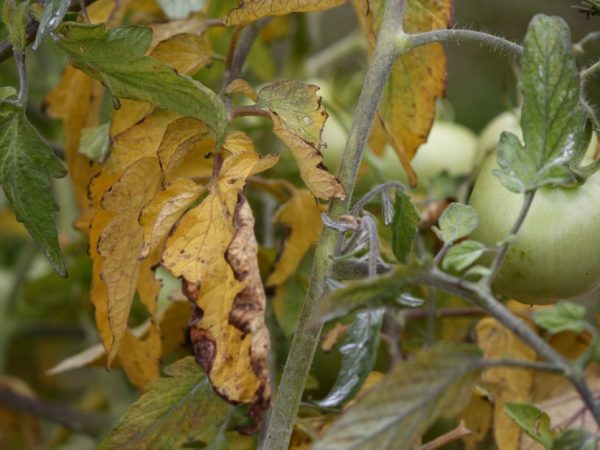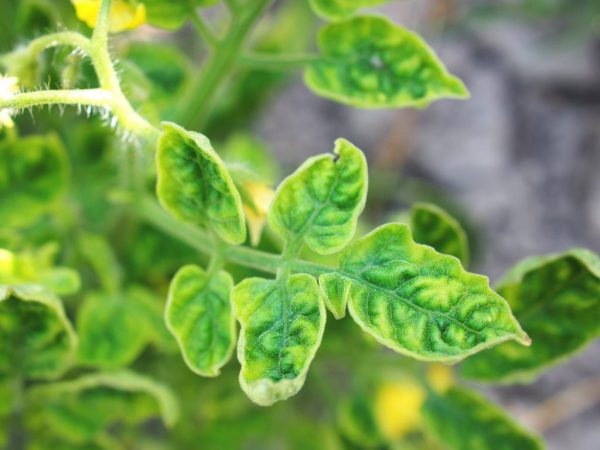Tomato leaves for chlorosis: signs and treatment
Chlorosis is a disease that occurs when certain micronutrients are deficient. The development of such a disease is possible in tomatoes. With chlorosis, tomato leaves change color and turn yellow.

Tomato leaves for chlorosis: signs and treatment
This disease will not lead to the death of tomatoes, but they will be weak and it will not be possible to get a high-quality harvest from them. But using simple preventive measures can avoid this disease, and if it occurs, it can be cured.
The causes of chlorosis
The yellowing of leaves in tomatoes signals that something has gone wrong in development. Chlorosis is often the cause of this process. This disease is characteristic of many plants, both garden and indoor.
The main reason for the occurrence of chlorosis on tomatoes is a deficiency of trace elements. Depending on which element the plants lack, they are distinguished:
- iron;
- magnesium;
- manganese;
- zinc;
- potassium;
- molybdenum;
All these elements are present in small quantities in the soil, sometimes bushes lack them, or their assimilation is disturbed.
In agronomy, only iron deficiency is called non-infectious chlorosis. Everything else is just a deficiency of this or that element. Determination of this deficiency by changing the color, size and shape of the leaves is called leaf diagnosis.
Signs of the disease
They all have distinctive features that will help in the correct diagnosis. This will intensively heal the tomato bushes.
Iron
It occurs when there is a lack of iron. The leaf plate turns yellow, the veins remain green. Such a change in pigmentation appears on young leaves, the old ones remain green. Such a deficiency occurs in poor soils or in the case of poor iron intake due to heavy soil with a pH above 7.
On alkaline soils, the iron contained in the soil complex turns into an insoluble and, therefore, inaccessible form for plants. Gardeners often make mistakes when cultivating the soil and add large amounts of lime, which leads to iron deficiency in plants.
Magnesium
Tomato leaves turn yellow along the edge, only their base retains a green color. The outline of the non-yellowed part of the leaf has the shape of a triangle. This change is characteristic of both young and old leaves. After a while, they begin to fall off, the plant becomes weak and painful.
Manganese
In this form, a color change between the veins is observed on the leaves; these parts of the plate acquire a pale light green color.
Zinc

With a zinc deficiency, the leaves become small
On the leaves of tomatoes with a zinc deficiency, a creamy yellowish spot appears. The veins remain green. Young leaves grow small on short and weak cuttings.
Potassium
If the disease is associated with a potassium deficiency, then the leaves begin to turn yellow from the end towards the base. Over time, they fall off, the young ones become smaller, even the stems become weak.
The most important sign of potassium deficiency is a brown border around the leaves, the so-called marginal burn.
Disease prevention
To protect tomatoes from chlorosis, preventive measures are started even before the plants are planted in the ground.
- The pH level is checked, the soil should be below 7, if it is higher, then the soil is acidified. To do this, dissolve 1 tsp of citric acid in 10 liters of water or squeeze one lemon. They are spilling the soil.
- The bed is carefully loosened if the soil is heavy and poorly drained, river sand and low-lying peat are introduced.
- Complex mineral fertilizers or humates enriched with macroelements are introduced into the soil.
- In the process of growing tomatoes, they regularly loosen the soil, regulate watering, and prevent stagnation of water.
All of these measures, combined with proper farming techniques, will help prevent disease, improve soil structure and quality, and help grow healthy tomatoes with a high-quality harvest. And tomato bushes will grow well, bloom and bear fruit.
Treatment
When the disease occurs already during the growth of the bushes, then they need to be treated. For this, chelated forms of fertilizers are used. They are highly soluble in water and are convenient for spraying bushes. With iron deficiency, use:
- Iron chelate;
- Ferrovit;
- Ferillen.
In addition to ready-made preparations, a chelate is prepared to replenish iron at home. For 1 liter of water, 2.5 g of citric acid, 4 g of ferrous sulfate are enough. The bushes are sprayed with this solution 3 times with a frequency of 10 days.
Kalimag, dolomite flour or Mag-boron will help get rid of magnesium chlorosis. Ash can also be used. For this, an ash solution is prepared. One glass of ash is dissolved in 10 liters of water and sprayed with bushes on a leaf.
In a situation where zinc deficiency has arisen, zinc oxide is used to feed tomatoes. Prepare a solution by adding 10 g of fertilizer to 10 water. The finished top dressing is sprayed on the bushes. You can also use zinc sulfate and zinc superphosphate to enrich the garden.
For the treatment of manganese chlorosis, a fertilizer such as manganese sulfate is used. This fertilizer has a prolonged effect and it is good to apply it during autumn or spring digging. To combat the disease, it is used in dissolved form. For 10 liters of water, 2 g of the substance is enough, manganese dissolves well in water with a temperature of 25 ° C. It is absorbed well at air temperatures above 20 ° C.
Potash chlorosis is treated by feeding tomatoes:
- kalimag;
- humate potassium;
- wood ash.
It is important, when applying dressings, even for the purpose of treatment, to observe dosage and not to overdo it. An overabundance of macro- and microelements can be detrimental to crops. It is important to remember that all fertilizers are applied on well-moistened soil, and spraying is carried out in the morning or evening.
Conclusion
The fight against chlorosis will not be difficult, it will bring results, but the effectiveness of the treatment can only be seen when new leaves with the correct color begin to grow. Chlorosis can significantly weaken plants, which can affect the quality of the crop. And also weak bushes are susceptible to disease. Therefore, it is better to take all preventive measures in the spring and protect tomatoes from this ailment.

